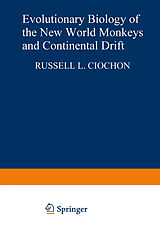Evolutionary Biology of the New World Monkeys and Continental Drift
Einband:
Kartonierter Einband
EAN:
9781468437669
Untertitel:
Advances in Primatology
Herausgeber:
Springer US
Auflage:
Softcover reprint of the original 1st ed. 1980
Anzahl Seiten:
564
Erscheinungsdatum:
15.01.2013
ISBN:
1468437666
It is now well known that the concept of drifting continents became an estab lished theory during the 1960s. Not long after this "revolution in the earth sciences," researchers began applying the continental drift model to problems in historical biogeography. One such problem was the origin and dispersal of the New World monkeys, the Platyrrhini. Our interests in this subject began in the late 1960s on different conti nents quite independent of one another in the cities of Florence, Italy, and Berkeley, California. In Florence in 1968, A. B. Chiarelli, through stimulating discussions with R. von Koenigswald and B. de Boer, became intrigued with the possibility that a repositioning of the continents of Africa and South America in the early Cenozoic might alter previous traditional conceptions of a North American origin of the Platyrrhini. During the early 1970s this con cept was expanded and pursued by him through discussions with students while serving as visiting professor at the University of Toronto. By this time, publication of the Journal of Human Evolution was well underway, and Dr. Chiarelli as editor encouraged a dialogue emphasizing continental drift models of primate origins which culminated in a series of articles published in that journal during 1974-75. In early 1970, while attending the University of California at Berkeley, R. L. Ciochon was introduced to the concept of continental drift and plate tectonics and their concomitant applications to vertebrate evolution through talks with paleontologist W. A. Clemens and anthropologist S. L. Washburn.
Inhalt
I. Geological and Paleontological Background.- 1 The Geologic Evolution of South America With Special Reference to the Last 200 Million Years.- 2 Early History and Biogeography of South America's Extinct Land Mammals.- II. Paleobiogeographic Models of Platyrrhine Origins.- 3 The Origin of the Caviomorph Rodents from a Source in Middle America: A Clue to the Area of Origin of the Platyrrhine Primates.- 4 The Implications of Rodent Paleontology and Biogeography to the Geographical Sources and Origin of Platyrrhine Primates.- 5 Origin and Deployment of New World Monkeys Emphasizing the Southern Continents Route.- III. Phylogenetic Models of flatyrrhine Origins.- 6 Eocene Adapidae, Paleobiogeography, and the Origin of South American Platyrrhini.- 7 On the Tarsiiform Origins of Anthropoidea.- IV. Evidence from Dental Anatomy Studies.- 8 Platyrrhine Origins: A Reappraisal of the Dental Evidence.- 9 Dental Evolutionary Trends of Relevance to the Origin and Dispersion of the Platyrrhine Monkeys.- 10 implications of Enamel Prism Patterns for the Origin of the New World Monkeys.- V. Evidence from Cranial Anatomy Studies.- 11 Nasal Structures in Old and New World Primates.- 12 Morphology, Function, and Evolution of the Anthropoid Postorbital Septum.- 13 Comparative Study of the Endocranial Casts of New and Old World Monkeys.- 14 Comparative Anatomical Study of the Carotid Circulation in New and Old World, Primates: Implications for Their Evolutionary History.- VI. Evidence from Other Comparative Anatomy Studies.- 15 Phylogenetic Relationships of the Platyrrhini: The Evidence of the Femur.- 16 The Phylogenetic Significance of the Skin of Primates: Implications for the Origin of New World Monkeys.- 17 Monophyletic or Diphyletic Origins of Anthropoidea and Hystricognathi: Evidenceof the Fetal Membranes.- 18 Comparative Study of the Sperm Morphology of South American Primates and Those of the Old World.- VII. Evidence from Karyological and Biochemical Studies.- 19 The Karyology of South American Primates and Their Relationship to African and Asian Species.- 20 South American Mammal Molecular Systematics, Evolutionary Clocks, and Continental Drift.- 21 Biochemical Evidence on the Phylogeny of Anthropoidea.- VIII. Synthesis, Perspectives, and Conclusions.- 22 Phyletic Perspectives on Platyrrhine Origins and Anthropoid Relationships.- 23 Paleobiogeographic Perspectives on the Origin of the Platyrrhini.- 24 Concluding Remarks.- Author Index.

Leider konnten wir für diesen Artikel keine Preise ermitteln ...
billigbuch.ch sucht jetzt für Sie die besten Angebote ...
Die aktuellen Verkaufspreise von 6 Onlineshops werden in Realtime abgefragt.
Sie können das gewünschte Produkt anschliessend direkt beim Anbieter Ihrer Wahl bestellen.
Loading...
Die aktuellen Verkaufspreise von 6 Onlineshops werden in Realtime abgefragt.
Sie können das gewünschte Produkt anschliessend direkt beim Anbieter Ihrer Wahl bestellen.
| # | Onlineshop | Preis CHF | Versand CHF | Total CHF | ||
|---|---|---|---|---|---|---|
| 1 | Seller | 0.00 | 0.00 | 0.00 |
